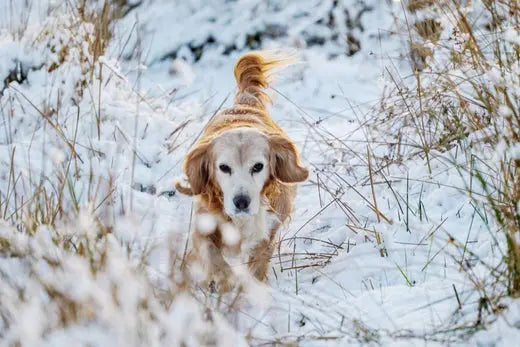From £6.99

Cold Weather Tips for Dog Owners
Understanding the Dangers of Cold Weather
As temperatures plummet during winter, dog owners must recognise the potential threats cold weather poses to their pets. Hypothermia and frostbite are serious conditions that can affect dogs, especially when exposed to freezing temperatures for extended periods. Hypothermia occurs when a dog's body temperature drops below normal, leading to symptoms like shivering, lethargy, and, in severe cases, unconsciousness. Frostbite, on the other hand, damages tissues, primarily affecting extremities such as ears, paws, and tails. Smaller breeds and those with short coats are particularly susceptible due to their limited natural insulation. Older dogs and those with health conditions may also be at increased risk. Monitoring weather forecasts and adjusting your dog's outdoor activities accordingly is essential.
Modifying Walk Times
When the temperature dips below freezing, it's wise to reconsider the duration of your dog's walks. Shortening the time spent outdoors can significantly reduce the risk of cold-related health issues. For smaller breeds, it's advisable to limit their outdoor excursions to about 15 to 20 minutes when temperatures fall below 0°C as a safety precaution. Additionally, choosing the warmer parts of the day, such as late morning or early afternoon, can make walks more comfortable. Avoid early mornings and late evenings when the chill is at its peak.
Selecting Suitable Canine Apparel
During colder months, equipping your dog with the right apparel can make a significant difference in their comfort and safety. Dog coats are essential, particularly for smaller breeds and those with short coats, providing an extra layer of insulation against the cold. When choosing a coat, opt for materials such as fleece or wool blends that offer warmth without adding excessive bulk. Ensure that the coat fits snugly yet comfortably, allowing for freedom of movement.
Booties are another valuable addition to your dog's winter wardrobe. They protect paws from harsh elements like ice, snow, and salt, reducing the risk of frostbite and chemical burns. When selecting booties, look for those with a non-slip sole to ensure your dog has good traction on icy surfaces. Water-resistant materials are preferable, keeping paws dry and preventing discomfort. Proper fit is crucial; booties that are too tight can restrict circulation, while those that are too loose may fall off during walks.
Consider layering for extra warmth on particularly cold days. A base layer such as a doggy sweater can be worn under the coat for additional insulation. Always prioritise your dog's comfort and mobility when dressing them for winter outings.
Indoor Activity Options
Indoor activities are an excellent way to keep your dog engaged and active when the weather outside is less than inviting. Interactive toys, such as treat-dispensing puzzles, are perfect for mental stimulation. These toys encourage your dog to think and problem-solve, making playtime both fun and rewarding.
Engaging in games like hide and seek can also provide much-needed exercise. Hide a favourite toy or treat and let your dog find it, which can help hone their natural instincts and provide a good workout.
Practising obedience training or teaching new tricks indoors offers a productive way to spend time together. Not only does this help to expend excess energy, but it also reinforces good behaviour and strengthens the bond between you and your pet.
For dogs with high energy levels, setting up a small obstacle course can be an exciting way to keep them physically active. Use household items like chairs, cushions, and blankets to create jumps, tunnels, and hurdles. This can provide both physical and mental challenges.
Interactive play, like tug-of-war or fetch with a soft toy, can also be a great indoor activity. These games offer physical exercise and can be particularly enjoyable for dogs who love to play with their owners.
Keep your dog entertained and mentally stimulated with these varied indoor activities, ensuring they remain happy and healthy even during the coldest months.
Cold Weather Paw Maintenance
Ice, snow, and salt can create significant challenges for maintaining your dog's paw health during the winter. To protect your dog's paws, paw wax or booties can be particularly effective during walks, shielding their pads from harsh elements and chemical de-icers. After each walk, ensure you clean your dog's paws with warm water to remove any residual salt or chemicals that could cause irritation or injury.
Regularly inspect your dog's paws for signs of cuts, cracks, or other injuries that might develop from exposure to cold weather conditions. Keeping their paw pads moisturised is also beneficial, as it helps to prevent dryness and cracking that are common during the winter months.
Trimming the fur between your dog's toes can reduce the accumulation of ice and snow, making walks more comfortable and lowering the risk of irritation. Additionally, keeping your dog's nails well-trimmed can improve traction on slippery surfaces, reducing the likelihood of slips and falls. By paying attention to these details, you can help maintain your dog's paw health throughout the winter season.
Nutrition and Hydration During Winter
In winter, your dog's dietary needs may change as their body works harder to stay warm. Ensure they receive a balanced diet that meets their energy requirements, especially if they are highly active. You might need to slightly increase their food portions to compensate for the additional calories burned. Opt for high-quality dog food rich in protein and healthy fats to provide sustained energy.
Hydration is equally vital, even in cold weather. Indoor heating can dry out the air, leading to dehydration. Always provide fresh water for your dog, and consider using a heated water bowl to prevent freezing if kept outside. Monitor your dog's water intake, as they might not drink as much in winter, which could lead to dehydration.
Additionally, incorporating omega-3 and omega-6 fatty acids into their diet can help maintain a healthy coat and skin during the dry winter months. Fish oil supplements or foods rich in these nutrients are beneficial.
By carefully managing their diet and ensuring adequate hydration, you can support your dog's health and well-being throughout the colder months.
